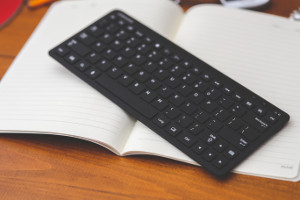Translators spend a lot of time behind computers, so it’s important to know how to use technology to its full potential. Keyboard shortcuts are just one of the ways that you can make technology work for you. They involve using a combination of keys to perform different functions without needing to use the mouse. Once you get the hang of keyboard shortcuts, they can speed up your work and even prevent injuries.
Using a mouse is one of the main causes of Repetitive Strain Injury (RSI), a term given to a range of musculoskeletal issues caused by repetitive movement and overuse. Keyboard shortcuts reduce the need to use the mouse and therefore make RSI less likely.

Here are some of the keyboard shortcuts that I find most useful as a translator using a Windows computer:
General
Alt+ Tab Switch between open windows
Press once to switch to the last open window or keep holding Alt and press Tab again to switch to another open window. This is almost certainly my most used keyboard shortcut. It saves so much time and energy.
Tab Cycle forward through options.
This is a versatile shortcut that can be used in many programs to move to the next option. For example, when filling out a form, it saves you having to click in the next box.
Shift + Tab Cycle backwards through options
The reverse of the above- useful if you go too far and need to go back.
Ctrl + X/C/V Cut/Copy/Paste
I’m sure most people already know these, but they’re so useful I had to mention them!
Ctrl + Shift + V Paste unformatted text
This is especially useful when working with text from a PDF or when copy and pasting text from different sources with different formatting.
(This doesn’t work in Word. See below for the Word shortcut.)
Ctrl+ Z/Y Undo/Redo
Ctrl + A Select all
Ctrl + F Find
Ctrl+ Shift Change keyboard layout
This is particularly useful when you need to type in a language that uses diacritics that aren’t available on an English keyboard, although you have to know the keyboard layout from memory.
Alt Gr + a/e/i/o/u Type an acute-accented letter
This is especially useful when typing in a different language and you don’t want to change the keyboard layout or have to keep using Insert > Symbol.
Application key (looks like a menu with a pointer icon, usually to the right of the space bar) Right click
Launching and closing programs
Windows key/Start key (Windows logo, usually to the left of the spacebar) Open the Start Menu
From there, you can type the name of any program, folder, file etc. and press Enter to open it.
Alt + F4 Close the current window
Another really easy way to launch applications that you use frequently is by creating a keyboard shortcut for a desktop item. For example, right-click on the desktop shortcut to your CAT tool and click ‘Properties’. Then, on the ‘Shortcut’ tab, type the desired keyboard shortcut in the ‘Shortcut key’ field. Then when you start up your computer, you can use these shortcuts to open the programs you need for that day. You can find a list of (normally) unused key combinations here. For example, I have Ctrl + Alt + M to open MemoQ, Ctrl + Alt + W to open Word, and Ctrl + Alt + T to open Thunderbird. You could even create shortcuts for projects that you’re currently working on.
File Explorer
Ctrl + Shift + N Create a new folder
F2 Rename a folder
Internet
Ctrl + Tab Cycle through open tabs
Ctrl + Shift + Tab Cycle backwards through open tabs
Press down scroll wheel on the mouse Open link in new tab
Although not really a keyboard shortcut, it is much quicker and easier than having to right-click and then select ‘Open link in new tab’. This is convenient when researching terms.
Ctrl + T Open a new tab
Ctrl + Shift + T Reopen the last tab that you closed
I use this one a lot since I’m forever closing things then realising that I still need them. This way is much easier than going into your history to find the last thing you looked at.
F5 (Ctrl + R) Refresh the page
F6 Go to the address bar
Ctrl + D Bookmark page/Add to favourites
Word
Alt + T + W Calculate word count
One of the first things that translators often do in Word is check the word count. Instead of having to navigate through menus, you can simply use the shortcut.
Ctrl + S Save
Ctrl + B/I/U Make the text bold/italic/underlined
Ctrl + H Find and replace
Similar to the Ctrl + F function, but in this case, whatever is found is replaced with whatever you input in the ‘Replace with’ field. This can save a lot of time if you decide to change a term, for example.
Ctrl + Spacebar Clear formatting of the highlighted text
Alt + E + S Paste special
As mentioned earlier, Ctrl + Shift + V does not work in Word. Paste special allows you to choose what formatting, if any, you want to keep.
Home Move to the start of the line
End Move to the end of the line
Shift + movement Select text
This can be used with any function that moves the cursor, such as Home/End/Left arrow/Right arrow/Page up/Page Down. This is helpful in situations when you want to format or delete a certain section of text.
Ctrl + Left/Right arrow Move the cursor one word left/right
Ctrl + Up/Down arrow Move the cursor up/down one paragraph
Ctrl + Page up/down Move the cursor to the beginning of the previous/next page
Ctrl + Home/End Move the cursor to the start/end of the document
Shift + F5 Return to the place in the document where the cursor was before the last movement
This is a convenient shortcut when you want to move to another part of the document to check something and then go back to where you were without having to scroll through looking for that point.
Ctrl + F6 Move between open Word documents
Bear in mind that not all shortcuts work in all operating systems, internet browsers or programs. Also, different shortcuts may work better for different people according to the way in which you use your computer. The best way to find the shortcuts that work for you is by exploring your computer and the programs that you use and simply giving different shortcuts a try. You can find a full list of Windows keyboard shortcuts here and a full list of Mac keyboard shortcuts here.
In Word, you can find a full list of shortcuts by pressing Alt + F8 to open the ‘Macro’ window. Next, scroll down the list of ‘Macros in’ to select ‘Word Commands’. Scroll down the list and choose ‘ListCommands’ then click ‘Run’. Now, choose the option ‘Current menu and keyboard settings’ to generate a file with all currently assigned keyboard shortcuts.
Of course, there are also keyboard shortcuts within CAT tools, which make them much more efficient. However, these tend to vary depending on the software that you use. You can normally find a list of shortcuts within the settings of your program. In most CAT tools, you can even edit or specify your own keyboard shortcuts.
If you like the idea of using keyboard shortcuts but don’t know where to start, a good idea is to create and print cheat sheets with a list of all shortcuts for the programs that you use the most. You can stick these cheat sheets up in your office until you memorise the shortcuts that you find most helpful. You should find that the time you put into mastering keyboard shortcuts will soon be offset by the time you save by using them.






Leave A Comment